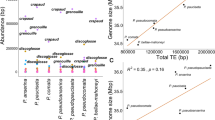Abstract
Repeat induced point mutation (RIP), a mechanism causing hypermutation of repetitive DNA sequences in fungi, has been described as a ‘genome defense’ which functions to inactivate mobile elements and inhibit their deleterious effects on genome stability. Here we address the interactions between RIP and transposable elements in the Microbotryum violaceum species complex. Ten strains of M. violaceum, most of which belong to different species of the fungus, were all found to contain intragenomic populations of copia-like retrotransposons. Intragenomic DNA sequence variation among the copia-like elements was analyzed for evidence of RIP. Among species with RIP, there was no significant correlation between the frequency of RIP-induced mutations and inferred transposition rate based on diversity. Two strains of M. violaceum, from two different plant species but belonging to the same fungal lineage, contained copia-like elements with very low diversity, as would result from a high transposition rate, and these were also unique in showing no evidence of the hypermutation patterns indicative of the RIP genome defense. In this species, evidence of RIP was also absent from a Class II helitron-like transposable element. However, unexpectedly the absolute repetitive element load was lower than in other strains.


Similar content being viewed by others
References
Agrawal N, Dasaradhi PVN, Mohmmed A, Malhotra P, Bhatnagar RK, Mukherjee SK (2003) RNA interference: biology, mechanism, and applications. Microbiol Mol Biol Rev 67(4):657–688
Almaraz T, Roux C, Maumont S, Durrieu G (2002) Phylogenetic relationships among smut fungi parasitizing dicotyledons based on ITS sequence analysis. Mycol Res 106:541–548
Bestor TH (1999) Sex brings transposons and genomes into conflict. Genetica 107(1–3):289–295
Clutterbuck A (2004) MATE transposable elements in Aspergillus nidulans: evidence of repeat-induced point mutation. Fungal Genet Biol 41:308–316
Crouch JA, Glasheen BM, Giunta MA, Clarke BB, Hillman BI (2008) The evolution of transposon repeat-induced point mutation in the genome of Colletotrichum cereale: reconciling sex, recombination and homoplasy in an “asexual” pathogen. Fungal Genet Biol 45:190–206
Daboussi M-J, Capy P (2003) Transposable elements in filamentous fungi. Annu Rev Microbiol 57:275–299
Daboussi M-J, Daviere J-M, Graziani G, Langin T (2002) Evolution of the Fot1 transposons in the genus Fusarium: discontinuous distribution and epigenetic inactivation. Mol Biol Evol 19:510–520
Deceliere G, Charles S, Biémont C (2005) The dynamics of transposable elements in structured populations. Genetics 169:467–474
Flavell AJ (1999) Long terminal repeat retrotransposons jump between species. Proc Natl Acad Sci USA 96(22):12211–12212
Flavell AJ, Pearce SR, Heslop-Harrison P, Kumar A (1997) The evolution of Ty1-copia retrotransposons in eukaryote genomes. Genetica 100:185–195
Galagan JA, Selker EU (2004) RIP: the evolutionary cost of genome defense. Trends Genet 20(9):417–423
Garber ED, Ruddat M (1994) Genetics of Ustilago violacea. XXXII. Genetic evidence for transposable elements. Theor Appl Genet 89:838–846
Garber ED, Ruddat M (1998) Genetics of Ustilago violacea. XXXIV. Genetic evidence for a transposable element functioning during mitosis and two transposable elements functioning during meiosis. Int J Plant Sci 159:1018–1022
Garber ED, Ruddat M (2000) Genetics of Ustilago violacea. XXXV. Transposition in haploid and diploid sporidia and germinating teliospores. Int J Plant Sci 161:227–231
Garber ED, Ruddat M (2002) Transmission genetics of Microbotryum violaceum (Ustilago violacea): a case history. Adv Appl Microbiol 51:107–127
Giraud T, Jonot O, Shykoff JA (2005) Selfing propensity under choice conditions in a parasitic fungus, Microbotryum violaceum, and parameters influencing infection success in artificial inoculations. Int J Plant Sci 166:649–657
Giraud T, Yockteng R, López-Villavicencio M, Refrégier G, Hood ME (2008) The mating system of the anther smut fungus, Microbotryum violaceum: selfing under heterothallism. Eukaryot Cell 7:765–775
Goddard MR, Burt A (1999) Recurrent invasion and extinction of a selfish gene. PNAS USA 96(24):13880–13885
Hamann A, Feller F, Osiewacz HD (2000) The degenerate DNA transposon Pat and repeat-induced point mutation (RIP) in Podospora anserina. Mol Gen Genet 263:1061–1069
Hood ME (2005) Repetitive DNA in the automictic fungus Microbotryum violaceum. Genetica 124(1):1–10
Hood ME, Katawczik M, Giraud T (2005) Repeat-induced point mutation and the population structure of transposable elements in Microbotryum violaceum. Genetics 170(3):1081–1089
Hurst LD (1992) Intragenomic conflict as an evolutionary force. Proc R Soc 248(1322):135–140
Ikeda K, Nakayashiki H, Kataoka T, Tamba H, Hashimoto Y, Tosa Y, Mayama S (2002) Repeat-induced point mutation (RIP) in Magnaporthe grisea: implications for its sexual cycle in the natural field environment. Mol Microbiol 45(5):1355–1364
Johnson LJ (2007) The genome strikes back: the evolutionary importance of defence against mobile elements. Evol Biol 34:121–129
Josse T, Teysset L, Todeschini A-L, Sidor C, Anxolabéhère D, Ronsseray S (2007) Telomeric trans-silencing: an epigenetic repression combining RNA silencing and heterochromatin formation. PLOS Genet 3(9):e158
Kidwell MG, Lisch DR (2001) Transposable elements, parasitic DNA and genome evolution. Evolution 55(1):1–24
Kumar S, Tamura K, Nei M (2004) MEGA3: integrated software for molecular evolutionary genetics analysis and sequence alignment. Brief Bioinform 5:150–163
Le Gac M, Hood ME, Fournier E, Giraud T (2007) Phylogenetic evidence of host-specific cryptic species in the anther smut fungus. Evolution 61:15–26
Lutz M, Piatek M, Kemler M, Chlebicki A, Oberwinkler F (2008) Anther smuts of Caryophyllaceae: molecular analyses reveal further new species. Mycol Res 112:1280–1296
Nee S, Maynard Smith J (1990) The evolutionary biology of molecular parasites. Parasitology 100:S5–S18
Rozas J, Sánchez-DelBarrio JC, Messeguer X, Rozas R (2003) DnaSP, DNA polymorphism analyses by the coalescent and other methods. Bioinformatics 19:2496–2497
Selker EU (2002) Repeat-induced gene silencing in fungi. Adv Genet 46:439–450
Yockteng R, Marthey S, Chiapello H, Gendrault A, Hood ME, Rodolphe F, Wincker P, Dossat C, Giraud T (2007) Expressed sequences tags of the anther smut fungus, Microbotryum violaceum, identify mating and pathogenicity gene. BMC Genomics 8:272
Acknowledgments
This work was supported by NSF award DEB-0446671 to M. E. Hood. We thank Misty Hurt for technical advice, Janis Antonovics for comments on an earlier version of this manuscript, and anonymous reviews for helpful comments.
Author information
Authors and Affiliations
Corresponding author
Rights and permissions
About this article
Cite this article
Johnson, L.J., Giraud, T., Anderson, R. et al. The impact of genome defense on mobile elements in Microbotryum . Genetica 138, 313–319 (2010). https://doi.org/10.1007/s10709-009-9419-2
Received:
Accepted:
Published:
Issue Date:
DOI: https://doi.org/10.1007/s10709-009-9419-2




